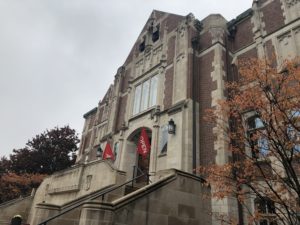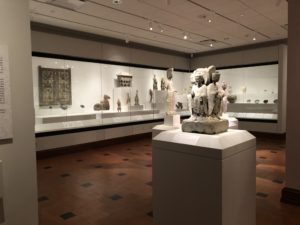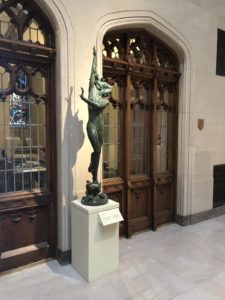Adding fresh technologies in exhibits and hosting special events can help museums attract a younger generation of visitors.
Bloop!
Every shift starts with turning on a walkie-talkie before I do my rounds in the galleries. I slip on my red uniform shirt and name tag, gather my study materials, and head toward my gallery. I check each thermometer for temperature and humidity, recording these on the daily checklist.
Lights? Check.
Plaques for each art piece? Check.
iPads charged and ready for use? Check.
Everything is as it should be.
More guards begin to fill their positions as the doors are unlocked and visitors start pouring into the galleries. My responsibilities as a David Owsley Museum of Art (DOMA) security guard start now, as I watch people come in and marvel at the works.

In a museum of world art, there’s something for everyone. Visitors, both students and community members, flock for docent-led tours. Many come for the peace of the Buddha in the Asia Gallery and the Meditation in the Museum events. They admire the individual brushstrokes of the paintings in the Bays. Their fingers itch to feel the smooth texture of the sculptures in the lobby.
While I’m nothing like Ben Stiller in Night at the Museum, and my artwork doesn’t come to life at night, my job is more than just telling people to stand back from the art. The other guards and I are the face of the museum. We are who visitors see every time they enter, so it is important we make them feel welcome. Personally, seeing people enjoy the galleries is comforting.
After all, it seems like the love for museums is slipping.
People are absorbed in technology.
They think artwork is just fruit, portraits, and landscapes.
People today want a more outstanding experience, often involving technology. A core standard of the American Alliance of Museums is to use whatever techniques and resources are deemed appropriate to achieve education goals.
With the technological component continuing to grow, there lies potential for visitors to increase engagement with the artwork and connect with it on a more emotional level.
Lara Kuykendall, an associate professor of art history at Ball State University, has worked with students to develop the DOMA Art Project mobile app. The idea started with Kyle Parker and Denise Jones, students who work with digital technology on campus. They wanted to create an app that utilized data mapping to explore art and history. The project required little funding, as the IT Department on campus provided the technology and students gathered the research.
In the app, the artworks are grouped into themes. Users can select a theme and let the app guide them through the galleries. The app also gives users freedom to express themselves by creating art memes, making their own artwork, and going on scavenger hunts throughout the museum. A search function also helps people find the specific pieces that interest them most.

Of course, guests who prefer classic tours can still check DOMA’s website to see available times. Kuykendall herself tends toward the traditional, but after seeing what her students created, she agrees that technology can be useful in museums
Modern museum visitors want to do more than stare at a painting and consider how it makes them feel. As younger generations become more invested in their phones and the latest tech crazes, museums look for new ways to bring in more visitors.
Museums across the country are integrating technology and evolving with society. Newfields in Indianapolis, for example, formerly known as the Indianapolis Museum of Art, rebranded last year with the desire to emphasize a combination of nature and artwork. Newfields stretches beyond its galleries into the gardens and surrounding buildings.
Newfields Lab provides interactive kiosks, projection mapping, motion-sensing games, and virtual or mixed reality games. These additions are meant to heighten visitor experience and promote interactive education. Similar to DOMA’s iPad programs, visitors can learn about artwork through these kiosks in the galleries. Projection mapping also allows museums to incorporate video sequences meant to evoke emotions such as fear or joy.
In the time that I have been a guard, I’ve seen various events and programs take place in the museum. The most surprising thing? Quite a few of them were not centered around art.
For example, I was posted as a guard for an economic event reception hosted at the museum. Featuring guest speaker James Otteson, the event wasn’t related to the museum’s art. It was odd to hear experts discussing economic enlightenments while staring at portraits or statues. But these events draw in the community and people who otherwise might have never considered visiting the museum.

Shannon Bryan, the administrative coordinator of DOMA, told me about a new program called SMART, which is in its second year. This program aims to bring every fourth-grader in Delaware County to DOMA to experience the artwork for both enjoyment and educational purposes. Students are taken on tours through the museum galleries, exploring central themes like religion and mythology. These tours focus on how artwork can appeal to all the senses, using engaging activities to appeal to young students’ ways of thinking.
DeLyla Bell, a student collections assistant at DOMA, says museums allow education and entertainment to intersect. I see the students come up with wild ideas, like which items they would put in a skewed self-portrait or what they think a sculpture is meant to represent. Randy Salway, DOMA’s exhibition design preparator, put it perfectly: “What makes a museum special to me is the opportunities it offers for contemplation, exploration, and learning.”
DOMA has both traditional and nontraditional events—this variation is what director Robert La France and assistant director Rachel Buckmaster agree people enjoy the most. For example, on the last Friday of every month, DOMA hires a DJ and has a cash bar for those 21 and over. Artists perform demonstrations of their creative processes. DeLyla says these relaxed events make the museum seem more accessible and cool to its target demographic.
During Art in Bloom, a summer event that pairs floral arrangements with artworks, the museum is transformed and draws visitors further into art through the sense of smell. Twice-monthly Music in the Museum performances appeal to the sense of sound. Events like these attract visitors who are looking for something unique.
Museums are meant to engage, intrigue, and educate visitors through the artifacts displayed. I’ve seen firsthand the awe on fourth-graders’ faces when they see our oldest art pieces, and the excitement patrons have when they enter a special exhibit to see featured artwork. I’ve watched countless tour groups wander through my gallery, the docent describing the rich histories and themes of the artifacts. It brings me joy to see the visitors happy when they arrive and happy when they leave, changed by the artwork they’ve seen.





